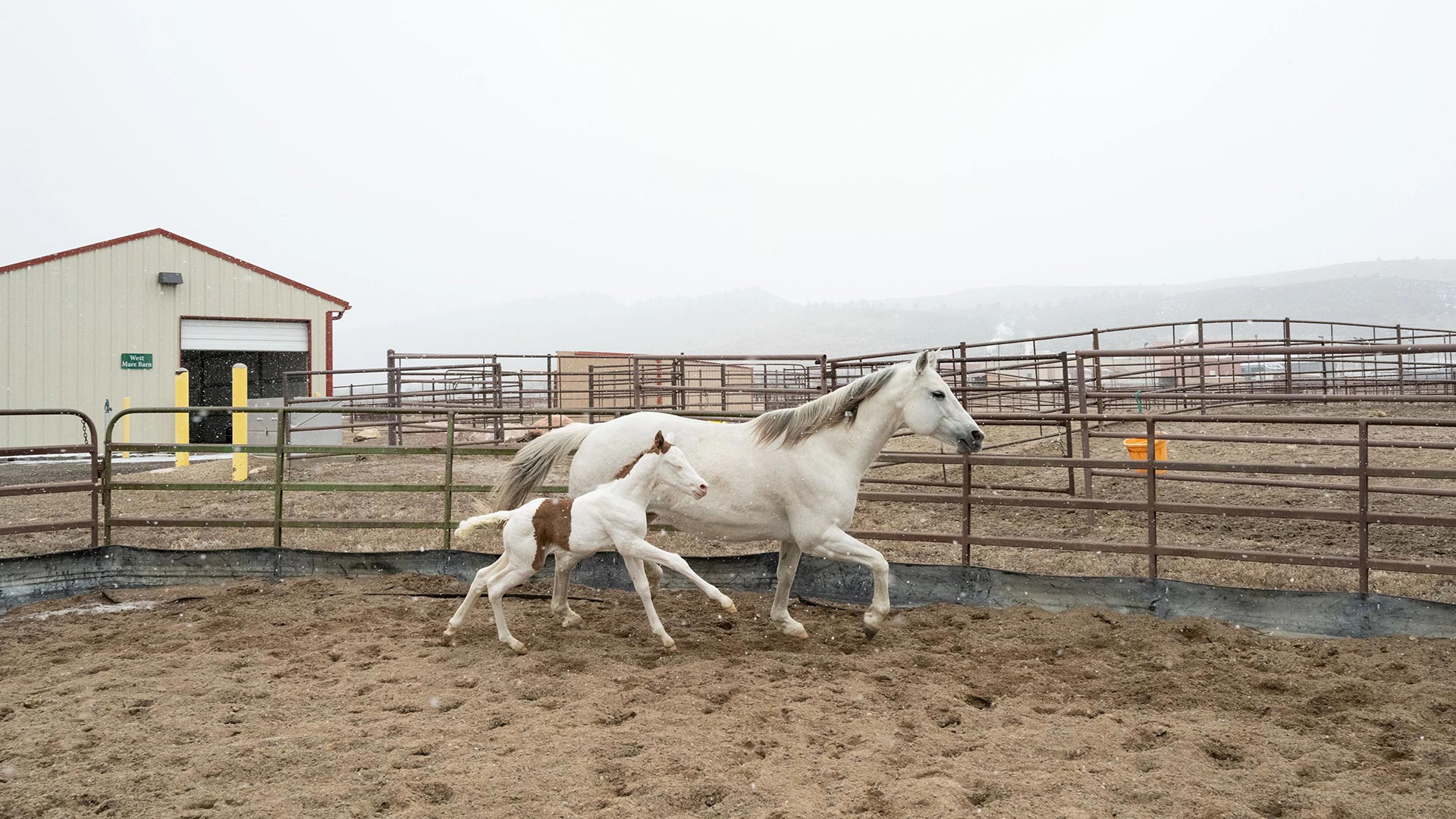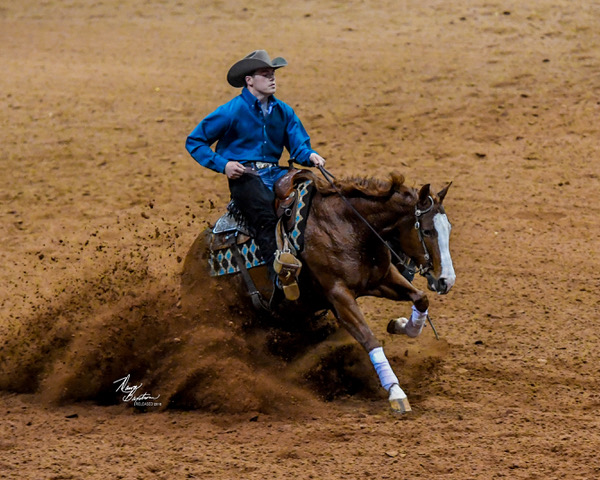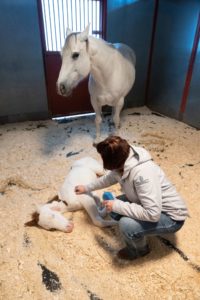
New colt “Steve” with surrogate mom Marge at the CSU Equine Reproduction Laboratory.
Photo by John Eisele
Ellie is an 11-year-old chestnut mare with a fetching white stripe on her face, and she’s about as loved as any horse could be.
That’s why she’ll spend the rest of her days munching grass in a Colorado field, after a series of medical interventions performed over the last several years by Colorado State University equine veterinarians. Ellie’s story, the latest chapter of which includes her becoming a mom – via a surrogate mare – to a healthy new colt, highlights the skilled care and expertise that has defined CSU’s Equine Reproduction Laboratory over the last half-century.
The Equine Reproduction Laboratory sits off Rampart Road on the Foothills Campus of CSU. Founded in the late 1960s as part of what is now called the Animal Reproduction and Biotechnology Laboratory, the lab is a state-of-the-art facility devoted to innovative research, exceptional teaching and outstanding clinical service, for both mares and stallions. The lab specializes in assisted reproductive technologies, from relatively simple embryo recovery and transfer, to more complex procedures like intracytoplasmic sperm injection, which is akin to current human in vitro fertilization procedures.
Spring is foaling season at the Equine Reproduction Laboratory, which means lots of client baby horses taking their first wobbly steps under the care of CSU faculty and staff.
Steve, born via surrogacy
In the wee hours of Feb. 23, Ellie, whose registered name is CBK Spooks Got Cash, became the biological mom to a feisty foal that CSU veterinary residents around the barn have taken to calling “Steve” (he’ll get an official registered name later). But Ellie didn’t birth Steve. That job went to Marge, a 13-year-old gray mare for whom birthing babies is old hat – she’s done it multiple times. Marge belongs to a herd of “recipient” or surrogate mares who pasture at the CSU lab and are periodically called upon to become pregnant on behalf of another female horse.

Ellie’s humans, Corliss and Bill Kellogg, have been making the nine-hour drive from their ranch in Gettysburg, South Dakota, for nearly a decade to have their horses cared for or bred by CSU. In 2020, they brought Ellie to CSU for surgery on a torn meniscus in her knee, which was performed by CSU equine orthopedist Dr. Laurie Goodrich. After rehabbing her for two years under the care of Dr. Melissa King, the Kelloggs longed to breed Ellie, a beloved member of their family who had been a decorated reining performance horse in her youth. She had previously carried a foal, but due to complications during the birth, the foal did not survive, and Ellie had had an emergency Cesarean surgery to save her life.
“We think so much of our animals, especially the ones that have gone through so much like Ellie,” Corliss Kellogg said. “Some people would have put her down, but I can’t do that. They deserve a chance in life just as well as a human does.”

CBK Spooks Got Cash a.k.a. “Ellie” during a reining performance in 2018.
Embryo transfer
To help Ellie have a baby, CSU veterinarians performed an embryo transfer. First, she was inseminated and made to become briefly pregnant with an early embryo. Eight days after ovulation, the embryo was flushed from her uterus and placed into the uterus of the recipient mare Marge.
This tried-and-true assisted reproduction method for horses was developed in the 1970s, but it was at CSU where it was transformed into a successful clinical procedure, spearheaded by then-CSU faculty member Dr. Ed Squires. Now, embryo transfer is routine and widely used, according to Dr. Patrick McCue, senior veterinarian at the Equine Reproduction Laboratory and the Iron Rose Ranch Professor of Equine Reproduction.
In the early days, McCue said, embryo transfers were performed surgically. When McCue arrived at CSU in the mid-1990s, he helped switched CSU’s clinical embryo transfer program to a faster, less invasive, non-surgical procedure that accesses the mare’s uterus via a catheter rather than an incision. This non-surgical procedure is still used today, including on Ellie and Marge.
The Kelloggs are hoping Ellie can have another foal, again through surrogacy, later this spring.

“The doctors have been phenomenal,” Bill Kellogg said. “We’ve been blessed. We put the time and money into it, and we have good people surrounding us. They brought Ellie back from a dark place.”
Due to Ellie’s previous injury and her need to live in milder conditions than the winters of South Dakota, the Kelloggs have made the decision to keep Ellie permanently at a facility in Colorado. That way she can continue to have access to CSU veterinarians and hopefully produce another foal.
The procedure used to transfer Ellie’s embryo into Marge is a common one. But the services provided by the Equine Reproduction Laboratory extend into much more difficult cases.
Sperm injection
A less frequent and more complex assisted reproductive technology performed at CSU is called ICSI, or Intracytoplasmic Sperm Injection. It is nearly identical to the human IVF procedure, in which an oocyte (egg) is fertilized outside the female body. The first foal ever conceived through ICSI-assisted reproduction was born at CSU in 1996. Dr. Elaine Carnevale, a faculty member in the CSU Department of Biomedical Sciences, grew CSU’s clinical ICSI program through the early 2000s and beyond, making the procedure more widely available to the horse-breeding world.
Among Carnevale’s trainees was Dr. Jennifer Hatzel, assistant professor in the Department of Clinical Sciences, who oversees the clinical ICSI program at the Equine Reproduction Lab today.
When the sperm injection work started to gain traction in the early to mid 2000s, CSU was one of the only facilities that offered the procedure, according to Hatzel. “CSU had barns full of horses that came up from Texas, Oklahoma … people would ship their horses up here to have this procedure done because their mares couldn’t get pregnant any other way.” Now, ICSI is used all over the world.
The ICSI sperm injection procedure in horses is similar to the in vitro fertilization procedure performed in humans, Hatzel explained. The mare’s eggs are collected using a trans-vaginal ultrasound probe and transferred into a petri dish. The egg is fertilized by direct injection of a single sperm into the egg using a specialized microscope. The fertilized egg is then placed into an incubator and monitored for embryonic development. Once the embryo has reached a viable stage, it is transferred either back into the original mare, or into a recipient (surrogate) mare.
The mare as a model for human reproduction
It might surprise some to learn that equine and human reproductive research have a lot to learn from each other, but experts at CSU, including Carnevale, Hatzel and others, have known this for a long time and have worked to collaborate and share knowledge. While mouse models are standard in human-focused clinical research, horses share important similarities to humans and may lend better translational data, particularly as it relates to female reproduction, aging and obesity.
“The mare tends to be a pretty good model for humans, especially in the world of aging,” Hatzel said. “Horses are one of the only species, short of dogs and cats, who live long enough to get to the point where they actually go through a similar process that women go through with menopause, which we call ‘mare-pause.’”
CSU continues to do cutting-edge research in equine medicine that could have translational applications to humans. Hatzel, for example, is working with industry partners on several different projects and methodologies to identify the healthiest sperm in a sample, in order to improve rates of success creating viable embryos. Such a technique could be used in both humans and horses someday, she said.

Equine Reproduction Laboratory client coordinator DeShane Williams and 3rd-year DVM student Savannah Kennedy with surrogate mare Marge and new foal Steve.